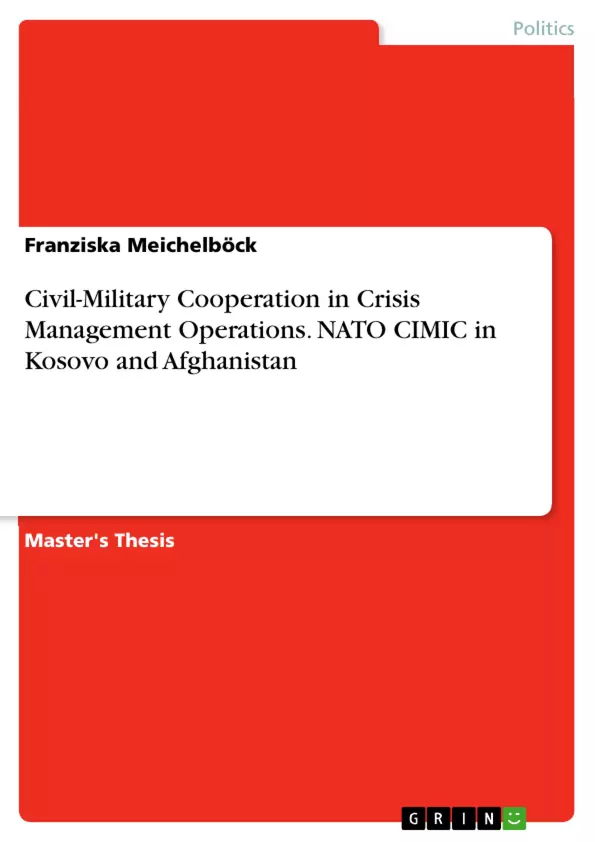The following thesis will offer a comprehensive outlook at civil-military cooperation. The first two chapters look at civil-military cooperation in general and demonstrate ways to analyse the concept of civil-military cooperation with approaches of civil-military relations and inter-organizational relations. The third and fourth chapter will look at the institutional theory and its explanatory framework for analysing civil-military cooperation. The analysis of civil-military cooperation in the institutional framework will occur with the method of the policy cycle and looks at the NATO CIMIC Framework and its implementation in the cases of Afghanistan and Kosovo.
Since the end of the cold war, the number of conflicts and humanitarian crises increased and the efforts of the international community in crisis management occur in highly complex situations in which sole military or humanitarian efforts cannot provide a solution to the situation. Civil-Military cooperation has become the catchphrase when talking about how to manage and solve complex crises. There are two different understandings of the term civil-military cooperation. In its basic form, it describes ‘the interaction between civilian humanitarian actors and international forces during complex emergencies’. The second understanding was developed by the military and referred ‘to the liaison and coordination processes and mechanisms that are established to facilitate relations between military forces and civilian agencies’ ‘in order to achieve military objectives’. Both definitions are broad and allow every organization to develop their understanding of civil-military cooperation. The most known concept is CIMIC by the North Atlantic Treaty Organization (NATO). However, other organization, like the United Nations (UN) or the European Union (EU), as well as humanitarian actors, have their understanding of civil-military cooperation. The interesting question is not how each organization understands civil-military cooperation, but how an organization formulate and implement the concept of civil-military cooperation as part of its institutional framework. Civil-military cooperation is used as a tool in crisis management, not by civilian organization, but by military one’s. [...]
Inhaltsverzeichnis (Table of Contents)
- Introduction
- Chapter 1: Background
- Chapter 2: Literature Review
- 2.1 Civil-Military Relations
- 2.2 Civil-Military Cooperation in Inter-Organizational Relations
- 2.3 Mixed Theoretical Approaches to Civil-Military Cooperation
- Chapter 3: Theoretical Framework and Methodology
- 3.1 Civil-Military Cooperation in Institutional Theory
- 3.2 Methodology
- 3.3 Case Selection
- Chapter 4: Analysis of the NATO CIMIC Framework
- 4.1 The Development of the NATO CIMIC Framework
- 4.2 NATO CIMIC in Kosovo
- 4.3 NATO CIMIC in Afghanistan
- 4.4 Evaluation of NATO CIMIC
- Conclusion
Zielsetzung und Themenschwerpunkte (Objectives and Key Themes)
This thesis provides a comprehensive analysis of civil-military cooperation, particularly focusing on the NATO CIMIC framework and its implementation in Kosovo and Afghanistan. The main objective is to examine how civil-military cooperation is understood, formulated, and implemented within institutional frameworks, particularly those of military organizations. The thesis aims to contribute to the understanding of civil-military cooperation in complex crisis management situations.
- The different understandings and applications of civil-military cooperation.
- The role of institutional theory in analyzing civil-military cooperation.
- The development and implementation of the NATO CIMIC Framework.
- The challenges and opportunities associated with civil-military cooperation in crisis management.
- The impact of civil-military cooperation on the effectiveness of crisis management operations.
Zusammenfassung der Kapitel (Chapter Summaries)
- Chapter 1: Background: This chapter explores the context and rationale behind civil-military cooperation in crisis management. It examines the advantages and disadvantages of cooperation, including the potential for division of labor, improved understanding, and the challenges of mistrust and militarization of aid.
- Chapter 2: Literature Review: This chapter provides an overview of existing literature on civil-military relations, inter-organizational relations, and theoretical approaches to civil-military cooperation. It explores various perspectives on the subject, highlighting different schools of thought and influential research.
- Chapter 3: Theoretical Framework and Methodology: This chapter introduces the theoretical framework of institutional theory and its relevance to analyzing civil-military cooperation. It outlines the methodology employed in the thesis, including the policy cycle approach for examining the NATO CIMIC Framework.
- Chapter 4: Analysis of the NATO CIMIC Framework: This chapter delves into the development and implementation of the NATO CIMIC Framework, focusing on the cases of Kosovo and Afghanistan. It analyzes the framework's effectiveness in promoting civil-military cooperation and addresses its limitations and successes.
Schlüsselwörter (Keywords)
The key terms and concepts explored in this thesis include civil-military cooperation, crisis management, institutional theory, NATO CIMIC Framework, Kosovo, Afghanistan, policy cycle, inter-organizational relations, humanitarian aid, militarization of aid, and force multiplier.
- Quote paper
- Franziska Meichelböck (Author), 2019, Civil-Military Cooperation in Crisis Management Operations. NATO CIMIC in Kosovo and Afghanistan, Munich, GRIN Verlag, https://www.grin.com/document/1024530



